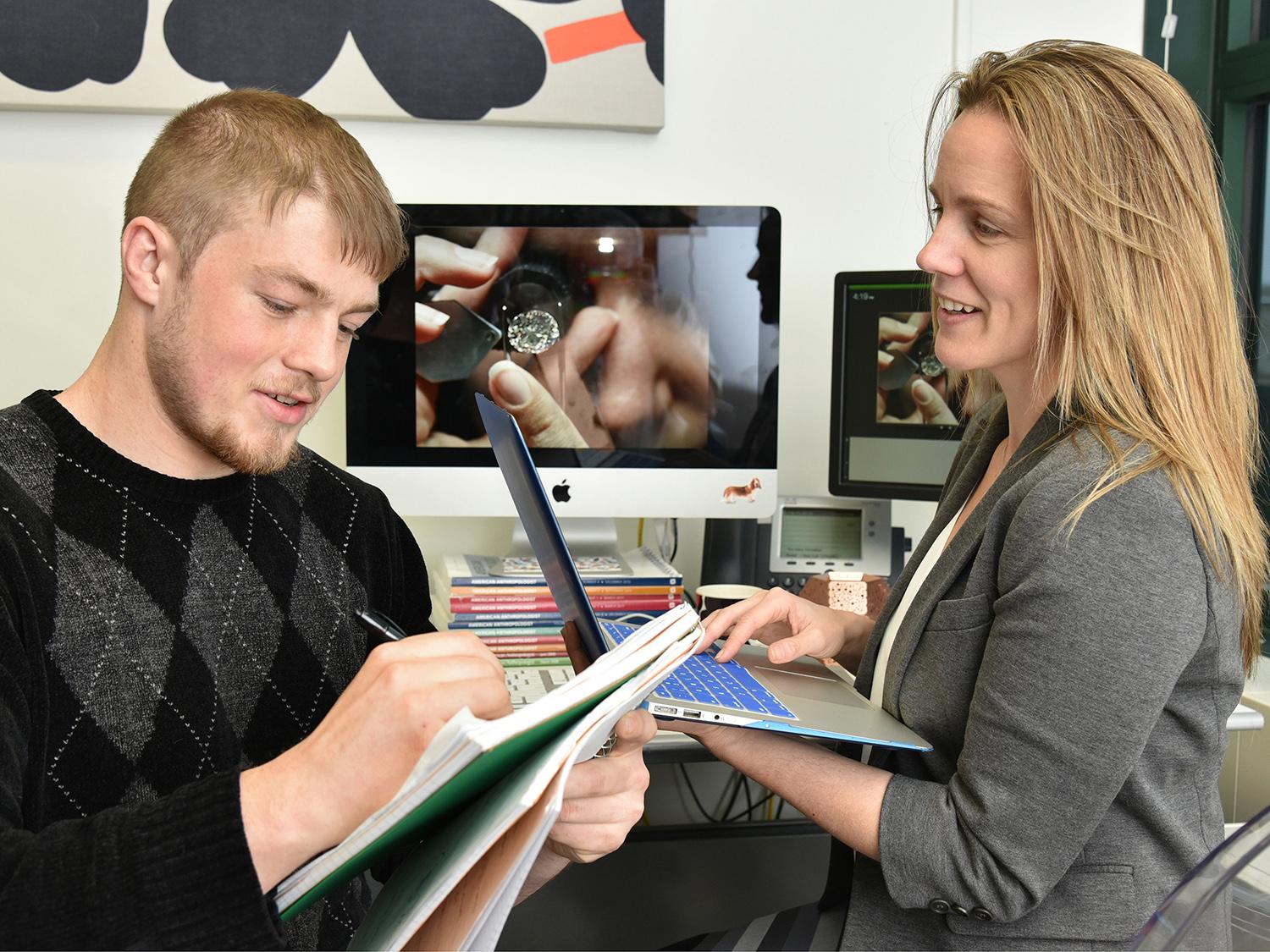Diamond research -- SUNY Oswego anthropology faculty member Dr. Lindsay Bell (right) and research assistant Howard Boutelle, a senior anthropology major, talk about a project to explore how transparency in the supply chain for diamonds is created.
Dr. Lindsay Bell, a SUNY Oswego anthropology faculty member, recently obtained funding to learn in detail how the diamond trade creates transparency -- a hot topic ethically and financially in the world of diamonds and other conflict-laden gemstones.
Wenner-Gren Foundation approved a grant of $16,650 to support Bell's research into the institutions, trade groups, companies and individuals whose work and practices can enhance or reduce a diamond's value to today's consumers, many of whom are determined to stay away from illicitly traded conflict diamonds, also known as blood diamonds.
As one of the early steps in the project, Bell and research assistant Howard Boutelle, a senior anthropology major, have set out to become certified gemologists, trained to identify and evaluate gems. That's in keeping with their research methods, which are ethnographic, focused on the systematic observation and analysis -- the insider's view -- of institutions, cultures or peoples.
"A lot of what we are doing is showing how a process works. We're not going in trying to show that this is a bad industry," said Bell.
Bell wrote in the Wenner-Gren grant application that how experts along the diamond supply chain create transparency "remains a theoretically nebulous and ethnographically elusive category of transparency that occludes more than it purports to reveal."
Boutelle, who plans to attend University of Texas-San Antonio for graduate school, has been an assistant to Bell for three years, and said he welcomes the opportunity to expand his research skills on the project. Both have completed an online course called "Diamond Essentials" from the Gemological Institute of America, and hope to travel this summer for a practical class on grading diamonds, required for certification as a gemologist.
"How do people learn to evaluate diamonds for origin, clarity and other characteristics?" Boutelle said. "That's our interest in this training."
Origin and value
Carefully documenting diamonds' origins can enhance value, but, Bell added, "so, too, is lots of value created when a diamond's origin is obscured. We need to study value creation. There are moments in a diamond's path (from mine to consumer) where companies can make certain things visible and other things less visible."
The researchers need to learn a great deal about the industry, though Bell has considerable background studying corporate ethics and socioeconomic inequality in diamond mining in Canada's arctic. Questions include: How is mining regulated and monitored through Swiss and Belgian governments, non-governmental watchdogs, gemologists in laboratories, auditors, trade groups -- experts all along the supply chain? How is the ethical value of transparency in diamonds constructed along the way?
The bulk of project funding is through a Swiss National Science Foundation grant with fellow researcher Filipe Calvão, assistant professor of anthropology and sociology of development at the Graduate Institute of Geneva. Calvão has long researched Angolan diamond mining and has extensive contacts in the diamond trade.
Bell hopes to travel to Switzerland -- a major commodity trade hub for cut diamonds and finished jewelry and the home of key watchdog organizations -- this summer, as well as perhaps to Antwerp, Belgium, the world's largest diamond evaluating, trading and cutting center. She and Calvão will write a book that should have impacts both academically and commercially.
"We hope consumers would ask better questions about so-called conflict diamonds. Human interaction and economic exchange often involves conflict in some form," Bell said. "One thing we want people to better understand is that diamonds are part of a complex web. People should keep asking richer questions about the complex ways commodities move from their place of origin into a global economy."




